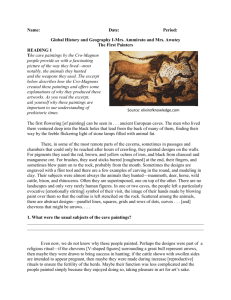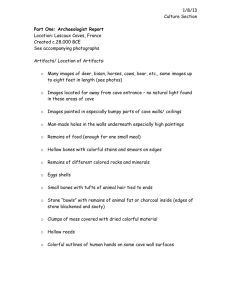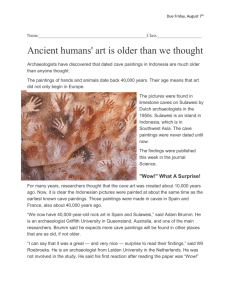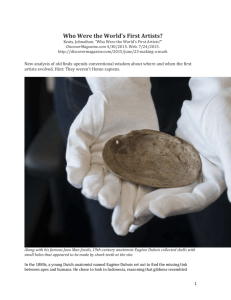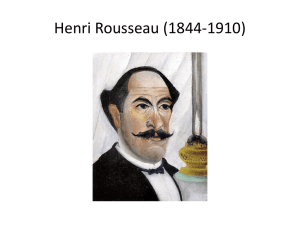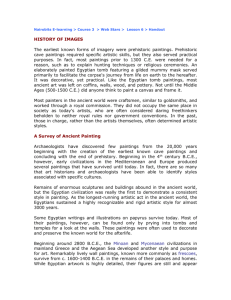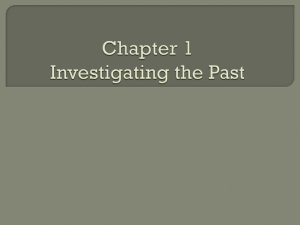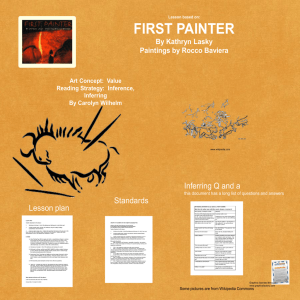Cave Painting - Prep World History I
advertisement
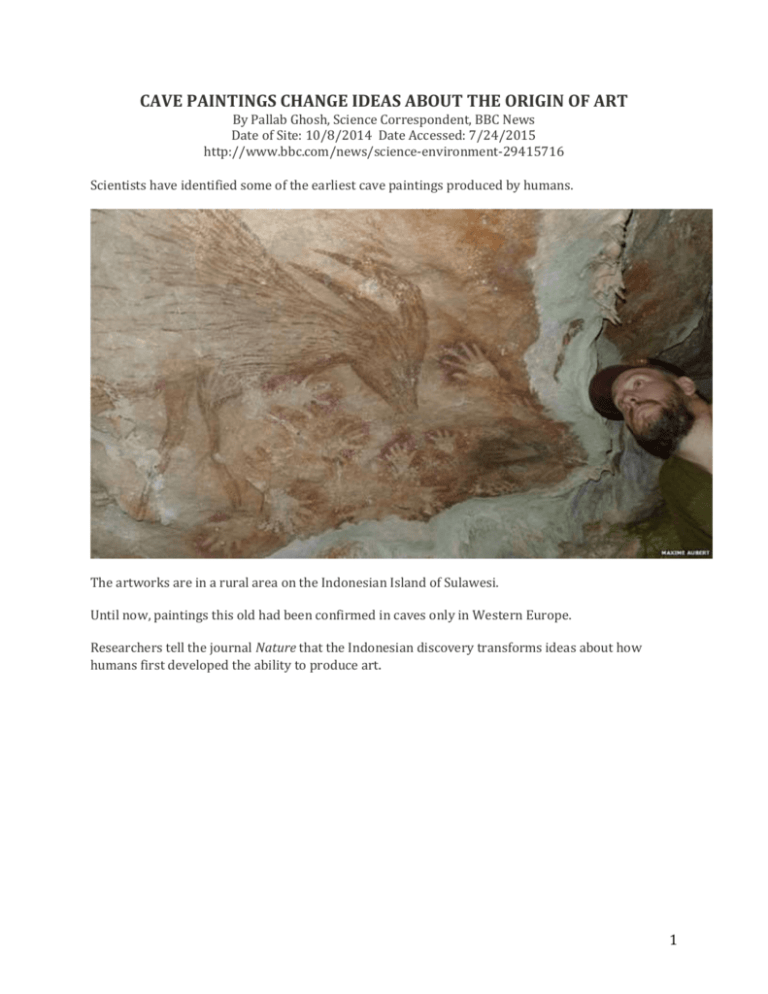
CAVE PAINTINGS CHANGE IDEAS ABOUT THE ORIGIN OF ART By Pallab Ghosh, Science Correspondent, BBC News Date of Site: 10/8/2014 Date Accessed: 7/24/2015 http://www.bbc.com/news/science-environment-29415716 Scientists have identified some of the earliest cave paintings produced by humans. The artworks are in a rural area on the Indonesian Island of Sulawesi. Until now, paintings this old had been confirmed in caves only in Western Europe. Researchers tell the journal Nature that the Indonesian discovery transforms ideas about how humans first developed the ability to produce art. 1 Australian and Indonesian scientists have dated layers of stalactite-like growths that have formed over coloured outlines of human hands. Early artists made them by carefully blowing paint around hands that were pressed tightly against the cave walls and ceilings. The oldest is at least 40,000 years old. This painting, from Bone, is of a variety a wild endemic dwarfed bovid found only in Sulawesi, which the inhabitants probably hunted. 2 There are also human figures, and pictures of wild hoofed animals that are found only on the island. Dr Maxime Aubert, of Griffith University in Queensland, Australia, who dated the paintings found in Maros in Southern Sulawesi, explained that one of them (shown immediately below) was probably the earliest of its type. At the top of the worn painting is a faint outline of a human hand. Below it is possibly the earliest depiction of an animal. "The minimum age for (the outline of the hand) is 39,900 years old, which makes it the oldest hand stencil in the world," said Dr Aubert. "Next to it is a pig that has a minimum age of 35,400 years old, and this is one of the oldest figurative depictions in the world, if not the oldest one," he told BBC News. There are also paintings in the caves that are around 27,000 years old, which means that the inhabitants were painting for at least 13,000 years. In addition, there are paintings in a cave in the regency of Bone, 100 km north of Maros. These cannot be dated because the stalactite-like growths used to determine the age of the art do not occur. But the researchers believe that they are probably the same age as the paintings in Maros because they are stylistically identical. The discovery of the Indonesian cave art is important because it shows the beginnings of human intelligence as we understand it today. Art and the ability to think of abstract concepts is what distinguishes our species from other animals - capabilities that also led us to use fire, develop the wheel and come up with the other technologies that have made our kind so successful. 3 Its emergence, therefore, marks one of the key moments when our species became truly human. The dating of the art in Sulawesi will mean that ideas about when and where this pivotal moment in our evolution occurred will now have to be revised. Compare the painting above from Bone with the one immediately below, which is from El Castillo cave in northern Spain, and dated to be 37,300 years old by researchers at Bristol University. The Sulawesian and Spanish paintings look very similar, and they are both about the same age. 4 For decades, the only evidence of ancient cave art was in Spain and southern France. It led some to believe that the creative explosion that led to the art and science we know today began in Europe. But the discovery of paintings of a similar age in Indonesia shatters this view, according to Prof Chris Stringer of the Natural History Museum in London. "It is a really important find; it enables us to get away from this Euro-centric view of a creative explosion that was special to Europe and did not develop in other parts of the world until much later," he said. The discovery of 40,000-year-old cave paintings at opposite ends of the globe suggests that the ability to create representational art had its origins further back in time in Africa, before modern humans spread across the rest of the world. "That's kind of my gut feeling," says Prof Stringer. "The basis for this art was there 60,000 years ago; it may even have been there in Africa before 60,000 years ago and it spread with modern humans." Dr Adam Brumm, who is the co-leader of the Sulawesi research, believes many well-known sites in Asia, and as far away as Australia, contain art that is extremely old but which has not yet been accurately dated. "If Sulawesi is anything to go by, where cave art was first recorded over half a century ago but was assumed to be young, a crucial part of the human story could be right under our noses," he said. Dr Muhammad Ramli, an archaeologist working with the Makassar branch of Indonesia's Preservation for Heritage Office, said that the Sulawesian paintings in Maros were being eroded by the pollution coming from an upsurge in local industrial activities. "In the beginning of the 1980s, there were a lot of cave paintings on this site in the form of hand stencils, as you can see right now. Presently, a lot has been damaged. "There is a strong necessity to conduct conservation studies in order to find the best way of preserving these sites so that the paintings may last," he told BBC News. 5
